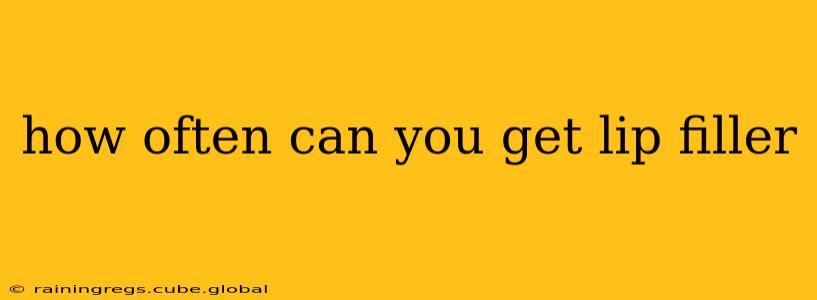Lip fillers have become increasingly popular for enhancing lip volume and shape. However, understanding the frequency with which you can safely and effectively receive lip filler treatments is crucial. This guide will explore the optimal timeframe between treatments, factors influencing the frequency, and potential risks associated with overly frequent injections.
What Determines How Often You Can Get Lip Fillers?
The frequency with which you can get lip filler depends on several key factors:
-
Type of Filler: Different fillers have varying longevity. Some hyaluronic acid fillers can last for 6-12 months, while others may only last 3-6 months. Your injector will advise you on the expected lifespan of the specific filler used.
-
Individual Metabolism: Metabolic rate plays a significant role in how quickly your body breaks down the filler. A faster metabolism may mean the filler dissolves sooner, requiring more frequent top-ups.
-
Desired Results: If you're aiming for subtle enhancement, you might need less frequent treatments compared to someone seeking dramatic volume changes.
-
Injection Technique: The skill and precision of the injector significantly impact filler longevity. A well-placed injection can provide longer-lasting results.
-
Lifestyle Factors: Sun exposure, smoking, and dehydration can all influence filler longevity. Maintaining a healthy lifestyle can help prolong the results.
How Long Do Lip Fillers Typically Last?
Most hyaluronic acid-based lip fillers last between 6 and 12 months. However, some individuals may experience longer-lasting results, while others might need touch-ups sooner. The filler's brand, the amount injected, and individual factors all contribute to this variability.
What Happens if You Get Lip Filler Too Often?
Getting lip filler too frequently can lead to several potential complications:
-
Increased Risk of Complications: Repeated injections increase the risk of bruising, swelling, infection, and other adverse reactions.
-
Overfilled Lips: Overly frequent treatments can result in an unnatural or over-full appearance. It's vital to find a balance that enhances your natural features, not overwhelms them.
-
Tyndall Effect: This is a bluish discoloration that can occur beneath the skin due to filler migration. It's more likely with frequent treatments.
-
Lumps and Nodules: Repeated injections in the same area can lead to the formation of lumps and nodules.
Can You Get Lip Filler Every 3 Months?
While some individuals might need touch-ups sooner than others, getting lip filler every 3 months isn't generally recommended unless specifically advised by your injector. This frequency significantly increases the risk of complications. It's always best to allow sufficient time for the filler to settle and for your body to react naturally before further injections.
What's the Recommended Timeframe Between Lip Filler Treatments?
The ideal timeframe between lip filler treatments is typically 6 to 12 months, but this can vary. Your injector will assess your individual needs and provide personalized guidance on an appropriate schedule.
How to Find a Reputable Injector?
Choosing a qualified and experienced injector is paramount to ensure safe and effective results. Look for a licensed medical professional specializing in cosmetic injectables with a strong reputation and positive reviews. Always consult with them about the appropriate frequency for your treatment based on your individual circumstances and desired outcomes.
Disclaimer: This information is for general educational purposes only and does not constitute medical advice. Always consult with a qualified medical professional for personalized advice and treatment. The frequency of lip filler treatments should be determined in consultation with your doctor or a qualified aesthetic practitioner.
